
JANE BURN – POETRY AS HARD GRAFT, INSPIRATION, REACTION OR EXPERIMENT?
I interviewed poet & artist Jane Burn who won the Michael Marks Environmental Poet of the Year 2023-24 with A Thousand Miles from the Sea.
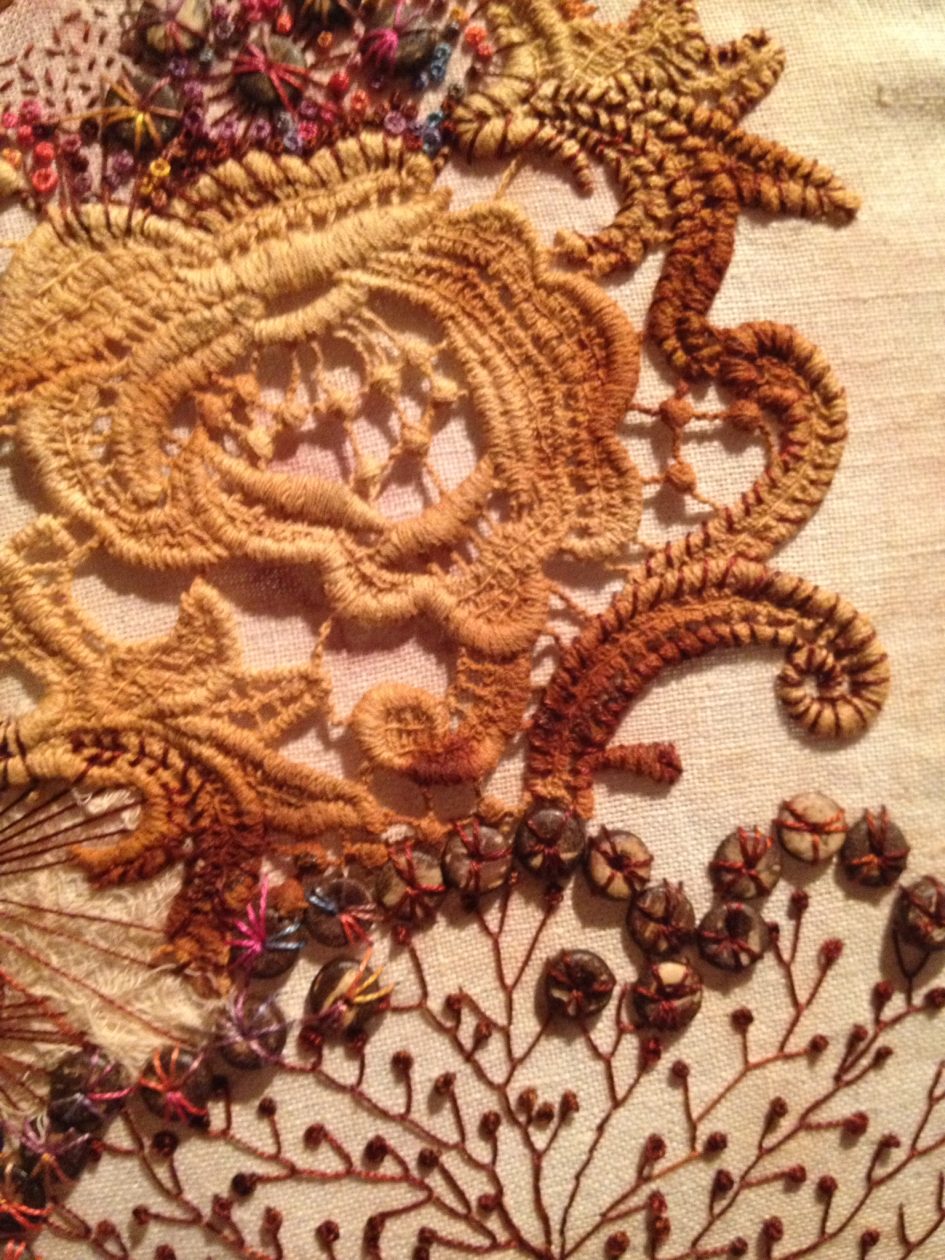

I interviewed artist Paula Watkins, author of Cut, Shape, Stitch, who creates her own life-enhancing artworks in a range of materials. Paula is a community artist and teacher, passing on her gift by showing adults and children how to express themselves through textiles, stitch and mixed-media.
Leslie: How have your background and key formative experiences contributed to your development as an artist?
Paula: As a young girl I enjoyed art so much that I had presumed that it would be my career with teaching as an additional choice. Yet when it came to careers advice at school I was told to look into something more academic and discouraged from following my heart.
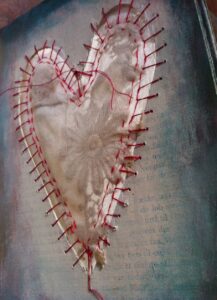
When I found art again I found such a need for immersing myself in it in every way I could that I wanted to try everything! I found my real calling was in textiles and stitch but in conjunction with these, mixed media made me feel like a child again. I was let loose with a box of paints and the whole world of possibilities waiting for me!
This same experience has made my teaching practice a way of encouraging my learners to try everything without the fear of failure. Just to immerse themselves in the joy of art. I have found so many people have an experience of being told that they ‘can’t do’ art because they can’t draw a perfect vase of flowers. They lost their confidence with art as a result. Often they lost their confidence in many aspects of life.
It has been interesting to find that as we give one another the confidence to be fearless in art that they lose their fear of other bad experiences. It is a very powerful experience.
Leslie: Can you give us a picture, please, of how you work by yourself and how you recharge your batteries.
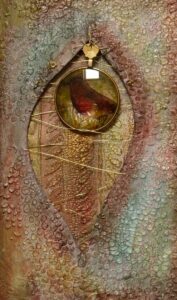
Paula: I don’t very often get to make art just for myself these day because I am so busy with teaching and making workshop samples but when I do, I love to work in art books. Books are one of the loves of my life! The pages of a book give me comfort and recharge my batteries. I lose myself in a book!
Art books can take many forms and involve all kinds of media. Altered books and fabric books are my absolute favourites and when the pages are made of the softest vintage blanket or silk and old linen that’s all the comfort I need.
Book art also allows me to use my imagination to create miniature worlds and to tell stories through images and textures. They are a way for me to display my collections of objects which I hope will excite the viewer’s imagination and their senses. Often they contain doors, pockets and detail which make the viewer look more closely.
I love to use images to evoke memories. For example some of the vintage textiles and ephemera that I use can remind us of objects our grandmother may have used or of a piece of childhood clothing.
I have found in teaching book making as an art form that it promotes a love of books in all their forms and makes people further appreciate and cherish the written word.
How do I work? If I need to be in my own little zone, I do it at the kitchen worktop dressed in my pyjamas! Usually on a Sunday.
Leslie: Which of your five senses lead when you’re working artistically and when you’re taking part in the everyday world? How does that preference show in your artistic creations?
Paula: I am of course led by sight. Colour combinations in my head keep me awake at night sometimes! I am enthralled by the colours all around me and look at tiny details in our beautiful natural world in awe.
However, as a textile artist, touch and texture are as important to me as colour and form. I am very interested in building surface texture into paintings, journals and textiles with the use of found materials, stitch, embossing and layering. Texture can convey such strong feeling in art.
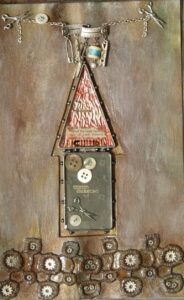
I had a body of art which was about memory loss and the sorrow of dementia. The artwork was in neutral colours with textures and stitch in red. Although the work was behind glass and I didn’t explain the meaning of the pieces, many people stood in front of the artwork in a gallery and cried. Some told me long and precious stories of their loved ones and of the sadness of their experiences. The power of art and the feelings conveyed by texture!
Leslie: What is the emotional core of your work?
Paula: The emotional core of my work is about being gentle. I am very concerned, from my experiences working in the community with vulnerable people, that we seem to have lost our sense of treating one another with care. Most of us carry burdens that are not apparent to the people around us. We need to choose to be kind. We need to rejoice in the little events and the everyday moments of joy.
In conjunction with this, my work is also about memory and telling our unique stories. I did some work with elderly people who were suffering with Dementia. We made very simple books together and wrote their stories as they remembered them. We also scanned and printed war medals and documents, photos and scraps of clothing as memory aids. They loved telling the stories that went with those memories.
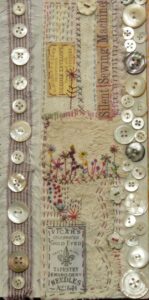
These little books became more precious to their families as the memories disappeared and could be used as a way to engage and remind their loved ones of their life events and in the end would become a record of their lives. Some of those people had amazing stories to tell.
Of course for some people the past is not about happy memories but it can be very important for them to tell those stories too and to feel they are being heard.
Using and handling found and natural materials can reinforce a feeling of the comfort and importance of the past. Some old things have a worn beauty and patina which are so lovely to incorporate into a piece of artwork just for their own sake too.
I use items such a rusty keys, buttons, washers, clock hands and broken jewellery. I also use old embroidered hankies and linens. I stitch these things onto a surface, sometimes embedding them into layers of fabric and paint. Occasionally there is just a hint of an object beneath a surface and sometimes it is the star of the show!
I often dye fabric by wrapping it around rusty objects and leave it in the garden for weeks. There is a wonderful surprise when it is unwrapped and the rust has done its work. It makes beautiful patterns and sometimes eats holes into the fabric.
Leslie:. Can you tell us about the collective side of art, please. What happens in workshops you lead and attend – the chemistry, how people gel, what they learn from each other, the psychology of group work and the insights you’ve experienced yourself while working collectively.
Paula: I love to teach! I honestly love to be in an environment where my learners inspire me as much as I am there to inspire them! I try to create a space where everyone is valued and feels they bring an important element to the group. We keep the knowledge that there are no such things as mistakes and that nothing matters more than enjoying the time to play.
This ethos applies to children’s sessions, family learning, adult art workshops and the courses for Mental Well-being and Art to Calm the Mind.
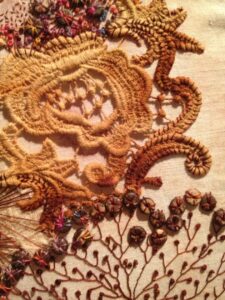
I find that the sessions generally become a place where everybody is mindful of each other and celebrate the artwork that is produced. I am most delighted if the learners demonstrate to one another how an experiment has turned out well or how they created an effect. Art is at its best when it is shared, enjoyed in a relaxed setting and learned for just the joy of it!
Some of the workshops that I do are crazier and more dynamic than this however. The workshops for art students and the guilds can be ones where the whole day is about cramming as many techniques and media into a session and mixing it all up. Some truly amazing results come out of these sessions and we all fall asleep when we get home!
Lastly, a word about the healing power of Art. This Academic year the government has funded some workshops for Mental Health and Well-being. Organisations are providing workshops on many different subjects to give learners strategies to help avoid stress, anxiety, depression etc. I have been teaching classes on Art Journaling to Calm the Mind. The results have been phenomenal! Many of the learners have been new to art, new to journaling and out of education for 20 years or more. And yet, the bravery it has taken to step out of their life situations and give the workshops a try has been the start of a new way of looking at their lives. Through these sessions they have found a way to relax, think more positively and have found a way to have a bit of ‘me time’ when life gets in the way.
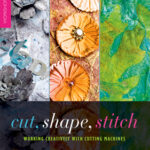
Art has crept into their lives and is there to stay.
Leslie: Thank you, Paula, for a fascinating interview. I see that news of your latest work and classes can be found at your blog Freckles and Flowers.
ABOUT LESLIE TATE’S BOOKS:

I interviewed poet & artist Jane Burn who won the Michael Marks Environmental Poet of the Year 2023-24 with A Thousand Miles from the Sea.

I interviewed ex-broadcaster and poet Polly Oliver about oral and visual poetry, her compositional methods, and learning the Welsh language. Polly says, “I absolutely love

I interviewed Jo Howell who says about herself: “I’ve been a professional photographic artist since I left Uni in 2009. I am a cyanotype specialist.


Poet Tracey Rhys, writer of Teaching a Bird to Sing and winner of the Poetry Archive’s video competition reviews Ways To Be Equally Human. Tracey,
| Cookie | Duration | Description |
|---|---|---|
| cookielawinfo-checkbox-analytics | 11 months | This cookie is set by GDPR Cookie Consent plugin. The cookie is used to store the user consent for the cookies in the category "Analytics". |
| cookielawinfo-checkbox-functional | 11 months | The cookie is set by GDPR cookie consent to record the user consent for the cookies in the category "Functional". |
| cookielawinfo-checkbox-necessary | 11 months | This cookie is set by GDPR Cookie Consent plugin. The cookies is used to store the user consent for the cookies in the category "Necessary". |
| cookielawinfo-checkbox-others | 11 months | This cookie is set by GDPR Cookie Consent plugin. The cookie is used to store the user consent for the cookies in the category "Other. |
| cookielawinfo-checkbox-performance | 11 months | This cookie is set by GDPR Cookie Consent plugin. The cookie is used to store the user consent for the cookies in the category "Performance". |
| viewed_cookie_policy | 11 months | The cookie is set by the GDPR Cookie Consent plugin and is used to store whether or not user has consented to the use of cookies. It does not store any personal data. |
2 responses
Thank you so much Leslie for giving me the opportunity to share my work. I’m looking forward to being at Berkhamsted Live in May.
What comes through in your interview and your work is that you are so positive.